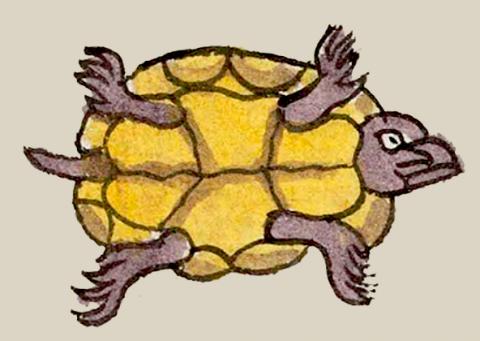ayotl (Mdz47r)
This simplex glyph of a turtle (ayotl) stands for the place name Ayotlan. It shows us its underside, as though the viewer were underneath it, looking up, watching it swim or walk. It is facing to the viewer's right. Its head, legs, and tail are all light brown, and its shell is a golden yellow, with some brown reinforcing the black line drawings that capture the character of the shell. Its one visible eye is white.
Stephanie Wood
The depiction of a turtle here provides the reading of ayotl as turtle, but it could be a phonetic indicator for other meanings. For example, the hard shell of the turtle had various uses, including forming the basis for a drum, with both the top and bottom remaining intact and with ends left open (see La Música Tejana, 1977, 5). It was played by being struck with a mallet or a deer antler (see Louise M. Pryke, Turtle, 2020). Gourds also have a visual resemblance to tortoise shells, and a hardness to them, which can result in the reading of ayotl as gourd. The term ayotl has an additional meaning, relating to the nature of water (a[tl] + -yotl) and thus to various liquids, such as strained herbal water, alcoholic beverages, or even relating to urine. Finally, the ayotli (squash) and the ayotl (turtle) have a strikingly similar look and sound, and yet very different meanings. Thus we are tracking them for homophony.
Also worth noting is the link between the glyphs for ayotl and yaotl (enemy combatant) which overlap significantly in the Matrícula de Huexotzinco. And, the turtle shell (carapacho in Spanish) served as a percussion instrument. The Museo de Sitio de Tlatelolco (2012, 259) provides an excellent example of one of these turtle-shell drums. This may underline another connection between the turtle and warfare.
Stephanie Wood
Stephanie Wood
c. 1541, or by 1553 at the latest
Stephanie Wood
Joseph Scott and Crystal Boulton-Scott made the SVG.
turtles, tortoises, tortugas
Autonomous-era stone carving of a turtle at the Templo Mayor museum. Photo by Robert Haskett, 2/15/2023.

ayo(tl), turtle or tortoise, https://nahuatl.wired-humanities.org/content/ayotl
turtle, tortoise
la tortuga
Stephanie Wood
Codex Mendoza folio 47 recto, https://digital.bodleian.ox.ac.uk/objects/2fea788e-2aa2-4f08-b6d9-648c00..., image 104 of 188.
The Bodleian Libraries, University of Oxford, hold the original manuscript, the MS. Arch. Selden. A. 1. This image is published here under the UK Creative Commons, “Attribution-NonCommercial-ShareAlike 3.0 License” (CC-BY-NC-SA 3.0).


